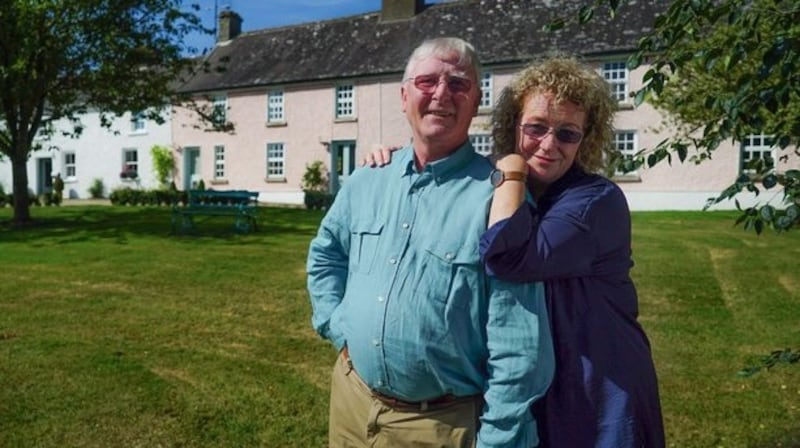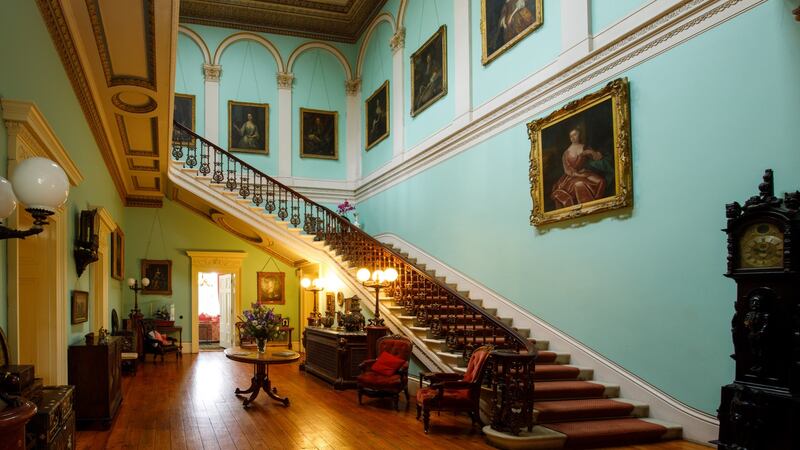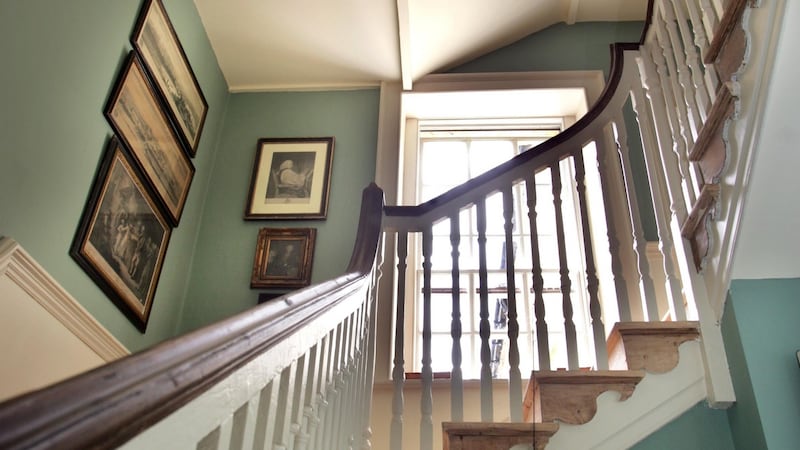If you watched RTÉ’s Home of the Year series and wanted to find out more about the houses, the good news is that you can visit at least one of them and see what it’s like for yourself.
Ballymurrin House in Kilbride, Co Wicklow, is a long, low, pink-painted old Quaker farmstead restored by owners Philip and Delphine Geoghegan as lovingly as only conservation architects can. A tour of the house, its meeting room and forge, provides all sorts of interesting insight into not just the religion’s history, but the lives of the congregation members who lived here, were imprisoned for their faith, or emigrated. The house is open to the public on certain days of the year in a scheme know as section 482, whereby owners of historic homes can offset a certain amount of refurbishment and upkeep costs against taxes.
History aside there is plenty to admire at Ballymurrin from the quaint kitchen, the sittingroom complete with inglenook fireplace and the breezy blue and white bedroom with it high timber ceiling. The house has just opened for the summer season.
Ballymurrin House, Kilbride, Co Wicklow

www.ballymurrinquakerfarmstead.eu
Open: May 2nd-10th, 17th-21th, 23rd-28th, Aug 19th-27th, 29th-31st, Sept 1st-3rd, 5th-9th, 2pm-6pm, two guided tours 2pm and 4pm
Fee: Adult/OAP/student €5/child free under 16 years but must be supervised
Fahanmura, Foxrock
Fahanmura is a Modern Movement house from the 1940s, with features of the movement including asymetricality, horizontal orientation and a flat roof. It has no cornices or eaves, is cube-like in shape with smooth, white walls and a sleek, streamlined appearance. No snip to build, its rounded corners are highlighted by wraparound windows. Characterised by little or no ornamentation, such homes were typically open plan. Art Moderne is not to be confused with Art Deco, caution the owners: “The Art Moderne style will appear sleek and plain, while the slightly earlier Art Deco style can be quite showy,” they say on their website, leaving no doubt as to which they prefer.
Fahanmura, Foxrock, Dublin 18
www.fahanmura.ie
Open: May 2nd-21st, 6th-16th, June 6th-16th, Aug 19th-27th, 9am-1pm
Fee: Adult €5, student €2, OAP/child free.
Curraghmore House
Stunning Curraghmore House in Waterford is the historic home of the ninth Marquis of Waterford whose ancestors (the de la Poers) came to Ireland in 1167. With some 2,500 acres of formal gardens, woodland and grazing fields, it’s the largest private demesne in Ireland and one of the finest to visit. The original castle, the last of four built by the de la Poers, is now encased in a spectacular Victorian mansion with flanking Georgian ranges. Given that the castle walls are 12ft thick, the decision to just leave it be is understandable. Outside there’s the Shell House folly built in 1754, and King John’s Bridge which was built in 1205 for the king’s visit but turned out to be a folly in itself, as he never arrived.
Curraghmore House, Portlaw, Co Waterford

www.curraghmorehouse.ie
Open: April 13th-Sept 30th, Wed-Sun; National Heritage Week, Aug 19th-27th, 10.30am-4.30pm
Fee: Full tour €15, house tour €10, garden & Shell House €7.50, garden €5. OAP concession full tour €13, under 12 years free.
Temple House

Temple House is a luxury guesthouse coming in the form of a classical Georgian manor, set in a private estate of more than 1,000 acres. It overlooks the 13th-century lakeside castle of the Knights Templar which gives it its name and has been home to the current owners, the Perceval family, since 1665. The family draws a connection even further into the mists of time, to Sir Perceval, one of the knights of King Arthur’s Round Table. The National Inventory of Architectural Heritage calls it a commanding house and a feature of national importance in the architectural heritage of Co Sligo that is full of historical, as well as architectural, interest. It’s also a lovely place for a wedding.
Temple House, Ballymote, Co Sligo
www.templehouse.ie
Tourist accommodation facility
Open: April 1st- Nov 15th
Castlecoote House
An elegant Georgian building incorporating parts of a 16th-century castle, Castlecoote is surrounded by woodlands, garden and a fast flowing river. Home to the annual Percy French Festival and Summer School, which takes place in July, it’s a good example of why the owners of such homes need help. The property, on which a succession of forts has been built down through the ages, looked set to fall into decay when it was taken over by a new owner and painstakingly restored in the 1990s. Guests can stay over for B&B or play lord of the manor on a self-catering basis.
Castlecoote House, Castlecoote, Co Roscommon
Tourist accommodation facility
www.castlecootehouse.com
Open: March 17th - October 31st
Leixlip Castle
Leixlip Castle has a date stone marking the year 1172. Almost uniquely in the country, it has been lived in continuously ever since. Though ultimately subsumed into the current house, which was completed in the 1830s, today it is owned by author and Georgian architecture buff Desmond Guinness. It also has such souvenirs of decor history as 17th-century tapestries in the hall, Savonnerie carpets in the library and 18th-century Chippendale in the dining room. To make a real day of it, and immerse yourself in a little Guinness family history along the way, approach via Arthur’s Way, a newly established tourist walking trail that passes local landmarks of the brewing family’s earliest days.
Leixlip Castle, Leixlip, Co Kildare
Open: May 8th-19th, Aug 19th-31st, Sept 1st, 9th-22nd, 9am-1pm
Fee: Adult €8, OAP/Student/Child €4
Meander, Foxrock
Meander is a two-storey, flat-roofed, detached house, dating from 1939. It was designed and to a large extent built by its owners – the architect couple Alan and Mairin Hope. It is constructed of blockwork and sheeted externally in horizontal cedar boarding while lined internally with oak and mahogany plywood. According to its Discover Ireland listing, the house retains its original windows, external and internal finishes. “The architects responded in a sensitive manner to the existing woodland setting which surrounded a series of natural ponds and developed the gardens. Meander has long been recognised as an example of Modernism in Ireland,” it says.
Meander, Westminister Road, Foxrock Dublin 18
Ruth O’ Herlihy, Tel: 087-2163623
Open: May 2nd-5th, 6th-10th, 15th-17th, 20th-23rd, June 7th-16th, 19th-23rd, Aug 19th-27th, 9am-1pm
Fee: Adult €5, OAP/ student/child €2
Ballinderry Park

The owners describe Ballinderry Park as a Palladian doll’s house, and it’s easy to see why. The lovely Georgian house is the epitome of small but beautifully formed. Rescued from dereliction 12 years ago by current owners Susie and George Gossip, they spent six painstaking years on what was no minor restoration job. The three dormer windows at the back had all collapsed, leaving the ancient agricultural implements that had accumulated in it over the years open to the elements. Now brought back to its former glory, it’s open to visitors as the kind of country house B&B that Little Beau Peep would have kept after throwing in the towel as a farmer.
Ballinderry Park, Kilconnell, Ballinasloe, Co Galway
www.ballinderrypark.com
(Tourist Accommodation Facility)
Open: April 1st- October 1st (other times for groups)
COULD YOUR HOME QUALIFY FOR SECTION 482 TAX RELIEF
To find out if your property qualifies for the Revenue’s section 482 tax relief on restoration, maintenance or conservation work, apply to the Department of Heritage for an assessment. It will make a determination based on the property’s architectural, historic or aesthetic merit.
“The important thing when you are applying is to find the historical significance of your property, what it is about it that makes it an exemplar, what it is about the property that shows it to be the best of what it is,” Delphine Geoghegan of iCon Architecture, and owner of Ballymurrin Quaker Homestead in Wicklow, a recent Home of the Year finalist.
“It’s some years since we went through the application process but I do remember it took quite a few weeks of paperwork, and that there was more involved than I had anticipated, but that once you get the paperwork done the department makes it very easy and it’s nice to be a part of it.”
Avail of relief
If you go on to avail of the relief, you must open the property to the public for a minimum number of 60 days a year. At least 40 of these must be between May and September, and 10 must be Saturdays or Sundays. The property must also be open for National Heritage Week in August.
If the building is in use as a tourist accommodation facility, it must stay open for at least six months of the year, four of which must be in summer.
“Be aware that there is a five-year period during which time, if you don’t meet the conditions, Revenue can claw back the relief, so it is quite a commitment. If you get sick or have security concerns, you can’t just pull out of it so consider it carefully before you proceed,” she says.
Under review
The value of the relief to property owners in 2014, the most recent year for which figures are available, was €2.8 million. The scheme is under review. “One of the issues about it is that it is dependent on your having income, in order to get tax relief on it. So it favours those who have money rather than those who haven’t, but who might therefore be more in need of the help,” says Geoghegan.
Muireann Noonan secured section 482 tax relief for the restoration of Springfield House in Mount Lucas, Co Offaly, a substantial country house property dating from the 1770s. Her application for approval was made through her architect and involved the compilation of a lengthy report detailing its historic and local significance.
“Section 482 relief encourages people to save houses,” says Noonan, who bought the house in 2005. “Springfield House would have perished within five years if it had not been restored.”
Downside
She doesn’t see the obligations to open it to the public as a downside. “We have that spirit anyway. I believe that when you have an old house, you’re a custodian of it. We have another property which was also restored, on North Great George’s Street, which didn’t qualify for section 482 because the assessor didn’t think it was of sufficient public interest. Yet when we open it as part of the Open House event, hundreds of people come to see it because people want to see old buildings, especially those that are used as family homes,” says Noonan.
“In Dublin we will often get someone knocking at the door to say they were born there, or carried across the threshold when they married. One very drunk man turned up to say he grew up there and could he have a look and, even though I was worried he’d fall on the stairs, he came in. The next day he came back stone cold sober with a box of chocolates and a bunch of flowers to say thanks. In Offaly it’s mainly locals who come. The way I look at it the house is very much part of my neighbours’ heritage too.”









